New Place
September 4th, 2007This weekend I re-read Bella Tuscany by Frances Mayes for about the hundredth time. Reading that book, her writing almost poetry, is like wrapping a warm and comforting blanket around me. I had seriously considered bringing that book with me when we travelled because of its ability to distract, comfort and calm. (As it turns out, there was absolutely no room for the book and I had much less need for it than I had anticipated.) There is a quote that I came across on Sunday that now seems more poignant than when I last read it 18 months ago,
“Setting off to see another country, I set off to see what is more grandly other- whole cultures, geographies, languages. Who am I in the new place? And who are they who live there?
If you settle in, even for two weeks, live in a house not a hotel, and you buy figs and soap at the local places, sit in cafes and restaurants, go to a local concert or church service, you cannot help but open to the resonance of a place and the deeper you go, the stranger the people become because they’re like you and they’re not.”
How true! How exactly, perfectly, succinctly true. I read that and instantly thought of Istanbul, how when we were there, we rented a flat for two weeks and indeed shopped for figs and soap at local markets, played backgammon and drank tea at local cafes. There’s no question that we still stood out as the stupid foreigners we were, there was hardly any chance of us blending in, but going for groceries, or visiting the hardware store, or briefly getting to know the patterns of our neighbours and internalizing the Ramazan drumming at dawn to the point where we were no longer woken up by it, made me feel like I was just slightly less tourist and very slightly more a resident. The difference is the thickness of a strand of hair but it made me happy to carry a jug of milk instead of a camera and to think that the people who saw me perhaps thought “There is a foreigner who lives here” rather then “Look, another tourist”.
A little of that feeling remains now that we are living in the United States. I am barely noticeable as a Canadian; until we speak in metric or use the word “toque” or have to show someone our ID, we are the Canadians that walk unnoticed amongst them. Most of the time, we are easily mistaken as Americans and I’m glad to blend in, the same way I was glad to blend in a shred in Turkey. I’m always especially pleased to be able to offer someone directions, and I’m asked often enough while walking the dog in the more touristy areas of town. Surely he makes me appear more a resident and occasionally, I am actually able to respond to a question in such a way that sustains the illusion; I wish I never had to say “Sorry, I’m not from around here…” and then not even be able to direct a visitor to a gas station for directions. But the longer we stay, and the more exploratory walks we take, the closer we will come to resemble San Franciscans, though I doubt we’ll ever shake the metric.
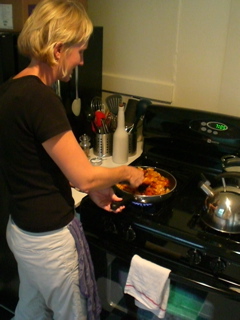 Meanwhile, in an effort to rekindle some of the travel vibe, and to use some of our souvenirs, we made a splendid curry. While in Udaipur, a man that we met, Krishna, set us up with a private cooking tutorial which involved an early-morning trip to the market and a lesson by his grandmother’s neighbour, a woman who cooked in a tiny, concrete kitchen tacked onto the rooftop courtyard of her building. After our lesson, Krishna obtained two sets of spices for us; we had told him we were not married so he had assumed that we lived apart and would, therefore, each require our own samples of curry, turmeric, cardamom and saffron. As a result, we have alot of spices to go through, a pleasant enough chore. This curry ploughed through a fair portion of the turmeric but we used whole cinnamon, bay leaves and cardamom pods. We also used two burners, which is one more than Krishna’s grandmother’s neighbour had. There’s no way we could’ve remembered and/or duplicated the chapatis she taught us to make- that will take an afternoon of patience and practice someday, an afternoon when we can invoke some travel memories of what it was like to cook in someone else’s kitchen.
Meanwhile, in an effort to rekindle some of the travel vibe, and to use some of our souvenirs, we made a splendid curry. While in Udaipur, a man that we met, Krishna, set us up with a private cooking tutorial which involved an early-morning trip to the market and a lesson by his grandmother’s neighbour, a woman who cooked in a tiny, concrete kitchen tacked onto the rooftop courtyard of her building. After our lesson, Krishna obtained two sets of spices for us; we had told him we were not married so he had assumed that we lived apart and would, therefore, each require our own samples of curry, turmeric, cardamom and saffron. As a result, we have alot of spices to go through, a pleasant enough chore. This curry ploughed through a fair portion of the turmeric but we used whole cinnamon, bay leaves and cardamom pods. We also used two burners, which is one more than Krishna’s grandmother’s neighbour had. There’s no way we could’ve remembered and/or duplicated the chapatis she taught us to make- that will take an afternoon of patience and practice someday, an afternoon when we can invoke some travel memories of what it was like to cook in someone else’s kitchen.
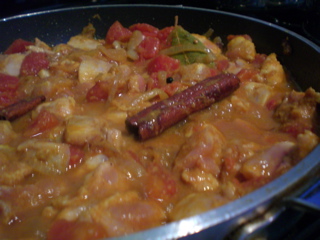
Sybarites

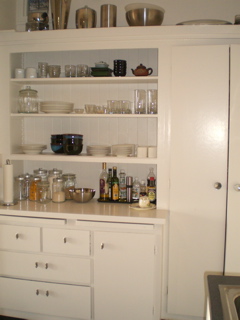 But before the stuff moved in, before we were wading through boxes and boxes of dishes and pots and pans, I made a lasagne. I’m reading
But before the stuff moved in, before we were wading through boxes and boxes of dishes and pots and pans, I made a lasagne. I’m reading 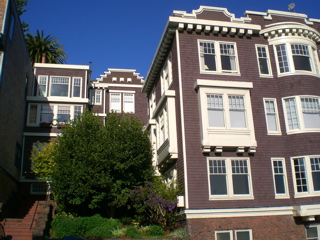
 After the failure of the
After the failure of the 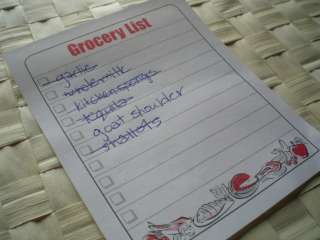 If you look carefully, you’ll notice one item on this list is not crossed off; we finally found a food that the magical land of Berkeley could not provide. Of all things, goat. I even called around to butchers and halal meat markets, and the artisan butcher at the market; the best response I got was to “try again around Easter”. And I’m not sure, but I think that’s because the Muslim holiday of Id-al-Adha, at which much goat feasting occurs, might fall in early April(??). I could be wrong, maybe that’s just when baby goats are at their most tender. (Meat is Murder. Tasty, tasty murder.)
If you look carefully, you’ll notice one item on this list is not crossed off; we finally found a food that the magical land of Berkeley could not provide. Of all things, goat. I even called around to butchers and halal meat markets, and the artisan butcher at the market; the best response I got was to “try again around Easter”. And I’m not sure, but I think that’s because the Muslim holiday of Id-al-Adha, at which much goat feasting occurs, might fall in early April(??). I could be wrong, maybe that’s just when baby goats are at their most tender. (Meat is Murder. Tasty, tasty murder.) Nevermind that it is the middle of summer and hot as an oven inside our west-facing kitchen in the evenings, I could just imagine the delicate, slightly gamey, savoury taste of this slow-cooked, oven-braised meat over pasta. It had to be done.
Nevermind that it is the middle of summer and hot as an oven inside our west-facing kitchen in the evenings, I could just imagine the delicate, slightly gamey, savoury taste of this slow-cooked, oven-braised meat over pasta. It had to be done. Did I mention that I made bread to go with it? My first ever attempt at bread making: pain à l’ancienne, a crispy, chewy baguette which, by the way, turn into rock solid pieces of fossilized bread if you leave them out overnight wrapped in towel. But I digress. The resulting meal that we enjoyed the following day was marvelously decadent and the only thing that could possibly have made it better was if it was cold outside.
Did I mention that I made bread to go with it? My first ever attempt at bread making: pain à l’ancienne, a crispy, chewy baguette which, by the way, turn into rock solid pieces of fossilized bread if you leave them out overnight wrapped in towel. But I digress. The resulting meal that we enjoyed the following day was marvelously decadent and the only thing that could possibly have made it better was if it was cold outside. I was left to figure something out for supper after having forgotten to go to the grocery store. I failed to find a use for the jar of kimchi or the fennel, but managed to put everything else together into a fine frittata. Thyme, Chili powder and salsa were added to the beatten eggs. The potatoes were well boiled, having learned a lesson for the last time I tried to make a frittata.
I was left to figure something out for supper after having forgotten to go to the grocery store. I failed to find a use for the jar of kimchi or the fennel, but managed to put everything else together into a fine frittata. Thyme, Chili powder and salsa were added to the beatten eggs. The potatoes were well boiled, having learned a lesson for the last time I tried to make a frittata.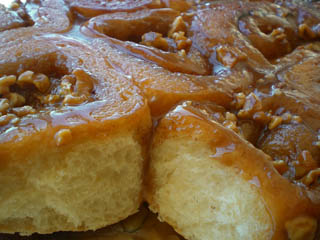 I was eyeing a bread baking book at Chapters before leaving on our around the world trip. Now that we’ve returned and I’ve been making bread again, I picked up
I was eyeing a bread baking book at Chapters before leaving on our around the world trip. Now that we’ve returned and I’ve been making bread again, I picked up 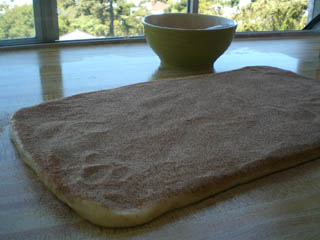 gave Janet a heart attack and that was in addition to the 1/2 cup of sugar that was rolled into the buns. Baking the buns was a bit of a challenge because the dough need to cook through to the bottom and the glaze needs to carmelize without turning into rock candy. In the end, most of the glaze was a little too stiff, but still tasty. If I had rotated the pan half way through and took them out five minutes earlier, they would have been perfect bakery-quality buns. Surprisingly, the glaze softened over the next 48 hours.
gave Janet a heart attack and that was in addition to the 1/2 cup of sugar that was rolled into the buns. Baking the buns was a bit of a challenge because the dough need to cook through to the bottom and the glaze needs to carmelize without turning into rock candy. In the end, most of the glaze was a little too stiff, but still tasty. If I had rotated the pan half way through and took them out five minutes earlier, they would have been perfect bakery-quality buns. Surprisingly, the glaze softened over the next 48 hours.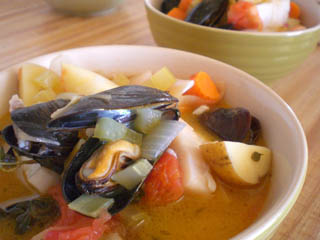 Janet’s first experiments in filleting a fish left us with excellent ingredients for fish stock, so we threw the cap and rake (read head and spine) into some water with a bay leaf and leek greens for about an hour. I’m told fish stock only needs a half hour, but I prefer to really work the fish smell into the house. When I’ve gone to all that trouble, I want people to walk into the house three days later and say, “Were you cooking fish?”
Janet’s first experiments in filleting a fish left us with excellent ingredients for fish stock, so we threw the cap and rake (read head and spine) into some water with a bay leaf and leek greens for about an hour. I’m told fish stock only needs a half hour, but I prefer to really work the fish smell into the house. When I’ve gone to all that trouble, I want people to walk into the house three days later and say, “Were you cooking fish?”
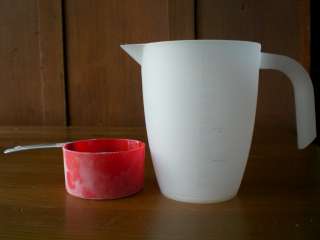 One disagreement that will forever be simmering under the surface of our kitchen dynamic is the difference between dry-measure and liquid-measure. Marc insists that one cup of dry equals one cup of liquid and I insist otherwise; surely there is a reason why they make nested measuring cups and separate ones with spouts. There have been experiments conducted in the kitchen to prove and disprove our opposing views and the result usually ends with a discussion of molecular make-up of liquids and solids and then with an agreement to disagree.
One disagreement that will forever be simmering under the surface of our kitchen dynamic is the difference between dry-measure and liquid-measure. Marc insists that one cup of dry equals one cup of liquid and I insist otherwise; surely there is a reason why they make nested measuring cups and separate ones with spouts. There have been experiments conducted in the kitchen to prove and disprove our opposing views and the result usually ends with a discussion of molecular make-up of liquids and solids and then with an agreement to disagree.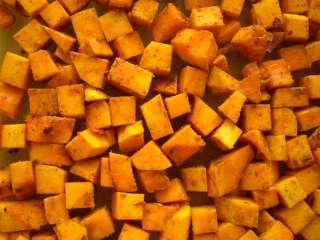 Living in Calgary at a high altitude for so long, I’m well in the habit of adjusting baking recipes to compensate for the pressure and that habit has further manifested itself in my cooking. If it seems silly to add three tablespoons of butter where two would do, then I’ll go with the two; if a recipe calls for fresh tarragon, I’ll double the amount because I love that herb. Marc, on the other hand, is much more scientifc about things. If the interweb says that scallops must be cooked at a temperature of 360°F for a period of time no greater than 2.6 minutes, then we’ll have to go out and buy a thermometer and a timer. His method yields perfectly cooked scallops every timewhile my method may yield perfectly cooked scallops some of the time, with lots of tarragon. Our focus is different, my results vary.
Living in Calgary at a high altitude for so long, I’m well in the habit of adjusting baking recipes to compensate for the pressure and that habit has further manifested itself in my cooking. If it seems silly to add three tablespoons of butter where two would do, then I’ll go with the two; if a recipe calls for fresh tarragon, I’ll double the amount because I love that herb. Marc, on the other hand, is much more scientifc about things. If the interweb says that scallops must be cooked at a temperature of 360°F for a period of time no greater than 2.6 minutes, then we’ll have to go out and buy a thermometer and a timer. His method yields perfectly cooked scallops every timewhile my method may yield perfectly cooked scallops some of the time, with lots of tarragon. Our focus is different, my results vary.